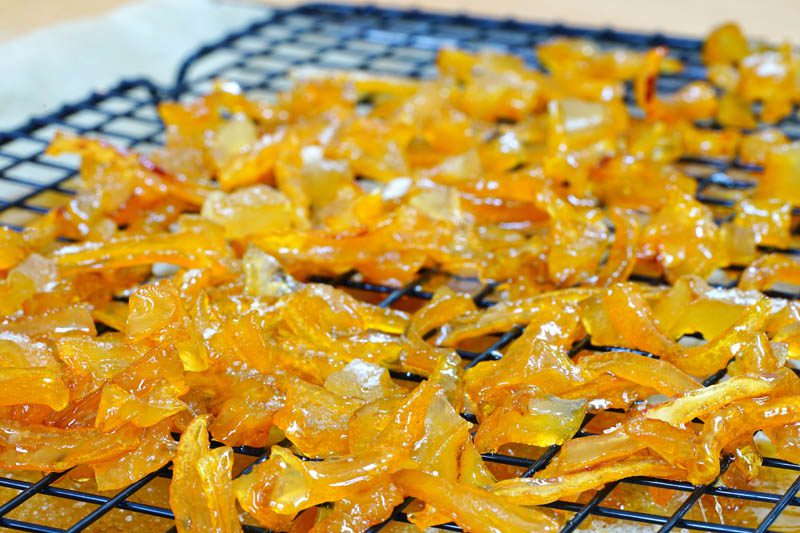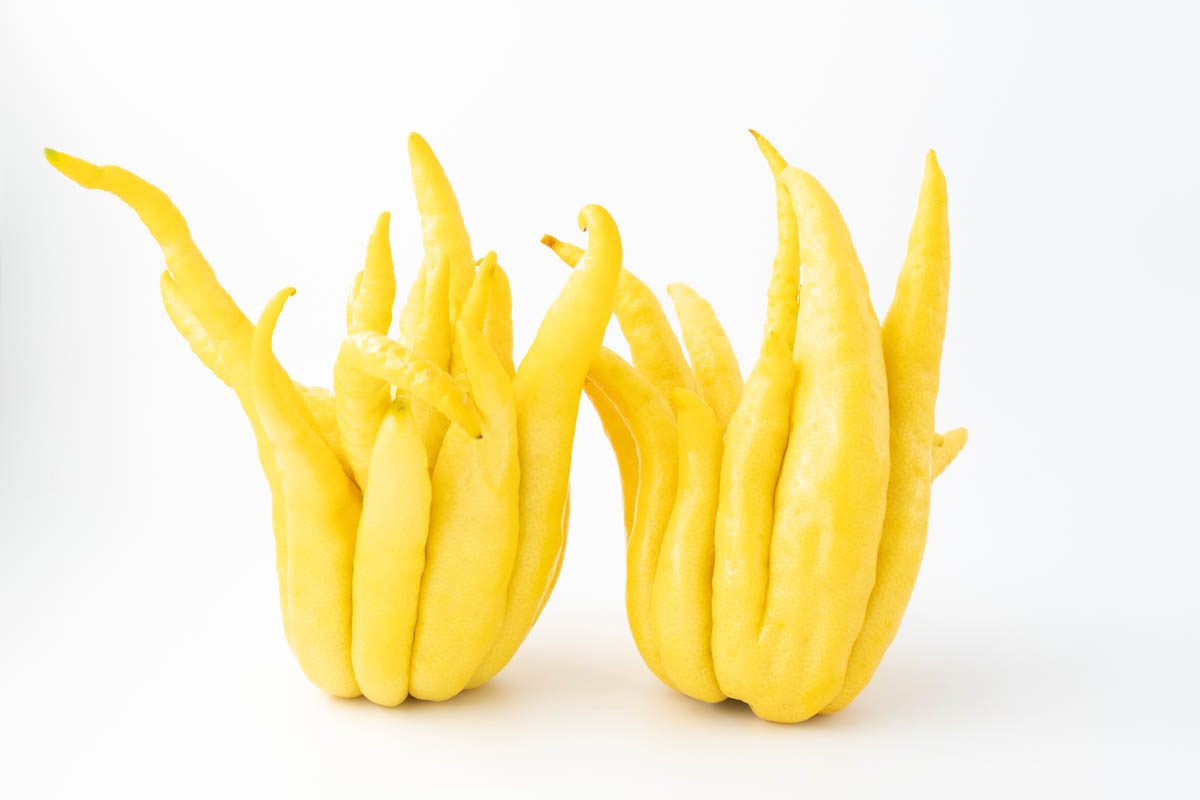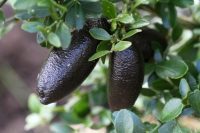Buddha’s hand citron (Citrus medica var. sarcodacylis), also known as fingered citron or bushukan in Japanese, is a type of citrus fruit that is native to northern India. It is named for its unusual shape, which resembles a hand with elongated fingers. Buddha’s hand citron is typically yellow or pale green in colour, and has a thin, bumpy peel that is covered in small oil glands. The fruit is fragrant and has a sweet, floral aroma. The tree on which it grows can reach heights of up to 20 feet and has long spiky thorns. Buddha’s hand citron is not widely grown or consumed, but it is popular in some parts of Asia and is often given as a symbol of good luck and prosperity.
In China, Buddha’s hand citrus is known as Fo-shou, and has been divided into several varieties including ‘Chuan’, ‘Guang’, and ‘Yun’, however, in the United States it is generally classed as one species.
Unlike other citrus, Buddha’s hand citrus contains no pulp or juice and is comprised entirely of the deeply aromatic rind with a thick layer of pith underneath.
Buddha’s hand citrus is a symbol of long life, happiness and good fortune in China, and is displayed in homes and temples. In Japan, the fruit is known as bushukan and is given as a household gift on New Year’s Eve to symbolise good fortune.
Buddha’s hand citron is a relatively rare and expensive fruit that is mostly grown in the subtropical regions of Asia and the Mediterranean. The highly fragrant and unusual fruit is gaining popularity among chefs and niche farmers.
Related: Sudachi citrus
Description

Buddha’s hand citrus is a small evergreen tree that reaches a height of 2 metres and a width of 1 metre. The plant produces white flowers during spring and summer, followed by small fruit, typically comprising between 5 to 20 segments. As the fruit matures, it takes on a vibrant yellow colour and can grow up to a length of 20 to 30 cm.
The fragrance of Buddha’s hand citrus is intense and can be detected from a distance. It is commonly described as having a sweet, lemony, and slightly floral aroma. Some people also detect notes of lavender, pine, and even a hint of spice in the scent of this fruit.
The scent of Buddha’s hand citrus is characterised by a delightful sweetness, accompanied by a distinct lemony fragrance, which is further accentuated by a subtle floral essence.
Growing information
Growing needs
- Light: Full sun.
- Water: Regular watering, allowing the soil to dry slightly between waterings.
- Soil: Well-draining, loamy soil; slightly acidic to neutral pH (6.0-7.0)
- Pests and diseases: Pests & Diseases: Watch for citrus leaf miners, spider mites, and aphids; avoid overwatering to prevent root rot.
Plant characteristics
- Type: Evergreen small tree or shrub
- Flowers: Spring
- Flower colour: White with a purple tinge
- Pollination: Self fertile
- Height: 2 metres
- Width: 1 metre
- Fruiting: Winter
Container growing
- Suitable for containers, should be a minimum of 40 cm diameter
Why is it called Buddha’s hand?
As the fruit develops, it splits longitudinally at the distal part of the stem, forming segments. These segmented sections of Buddha’s hand resemble the praying hands of Buddha.

What does Buddha’s hand citrus taste like?
Buddha’s hand citrus rind has a perfumed, citrus taste. Unlike the pith (the spongey white portion of the fruit just below the rind) of other citrus varieties which is bitter, buddha’s hand pith has a mild citrus taste. Buddha’s hand differs from other citrus varieties because it doesn’t contain pulp or juice.
What is Buddha’s hand used for?

Due to its shape, which resembles the hands of Buddha, Buddha’s hand citrus has been used in China and Japan for religious purposes or kept as an ornamental plant. Over recent years, it has become increasingly popular among chefs for its unique appearance and lemon-like flavour.
Buddha’s hand citrus rind and pith are rich in fragrant essential oils and have a wide range of uses. While the fruit contains no pulp or juice, Buddha’s hand can be substituted for any recipe that uses lemon rind.
- The fingers can be sliced and candied
- Use the peel to flavour vodka or gin
- Grate the peel and add to salad dressings
- Add the peel to cakes and biscuits
- Dried Buddha’s hand peel can be added to tea
- Dry and add to a potpourri mix
- The fingers can be used to make marmalade
- Add the peel to equal parts water and sugar to make a simple syrup
- Dry the peel in an oven or dehydrator, grate and add to salt
- Zest can be used as a replacement for lemon zest in recipes
- Buddha’s hands ‘limoncello‘ using simple syrup, vodka and thinly sliced peel
- Slice fingers, place in ice cube trays, fill with water and freeze, ice cubes can be added to soda water, vodka or gin and tonic
- Garnish drinks with sliced Buddha’s hand citrus
- In Asia, Buddha’s hand citrus is used in perfumes and scented products
I have personally eaten candied Buddha’s hand citrus and it was delicious. Hopefully, the fruit on my tree will mature and I will definitely make candied peel as well as ‘Buddha’shandcello‘, a traditional Italian liqueur made with vodka, sugar and citrus peel.
How to store Buddha’s hand citrus
Buddha’s hand can be stored for up to two weeks in the vegetable section of a refrigerator, or frozen for three months. When freezing Buddha’s hand, cut the top portion off and discard, place the remaining segments in a freezer-proof bag in the freezer.
How to grow Buddha’s hand citrus
Buddha’s hand citrus likes the same conditions as other citrus varieties, it prefers well-drained soil, in a full-sun location. Water when the top 2 cm of soil is dry. It is possible to grow in a pot, which should be a minimum of 40 cm wide and mulch well. Protect from strong winds.
Because citrus has shallow feeder roots, the best way to keep them cool in summer and warm in winter is to mulch well. Avoid underplanting as they do not like to compete with other plants for nutrients. Feed a good-quality citrus fertiliser 3 – 4 times a year.
Buddha’s hand citrus can not withstand frosts, therefore plants grown in cooler climates will need to be kept in a greenhouse or brought indoors during the cooler months.
Buddha’s hand citrus fruit is ripe when the rind it vibrant yellow.
Finger arrangements
Buddha’s hand citrus grows in different shapes and finger arrangements. They can be closed hand, open hand, closed hand, or have no order at all.
Gallery
Where to buy Buddha’s hand
Buddha’s hand citrus trees are available in specialist nurseries. Australian readers can purchase them from Daleys Fruit or Diggers Club when in season. Your local nursery may be able to order one or recommend a supplier. Look for a well-established tree. It is possible to grow Buddha’s hand from seed can take up to eight years before it produces fruit. If you have purchased a juvenile buddha’s hand citrus, remove fruit as it develops from the tree to allow the plant to focus on growing, and not producing fruit.
Buddha’s hand citrus fruit may be available from specialist grocery shops. The price can range from $25.00 to $50 per kilo depending on the season and availability.
Related: Australian finger lime
Medicinal uses
Buddha’s hand citrus leaf has significant antimicrobial activity against S. aureus and B. subtilis. In traditional Chinese medicine, Buddha’s hand citrus is said to be beneficial for the pancreas, liver, and stomach health and as a remedy for phlegm-induced cough.
Coumarin, limonin, diosmin and bergapten are aromatic organic compounds that relieve pain, inflammation and swelling.
Buddha’s hand citrus is rich in vitamin C and antioxidants, which can delay the onset of ageing by scavenging free radicals that cause oxidative damage to cells.
Buddha’s hand citrus recipes
Buddha’s hand is primarily used for its aromatic peel which is rich in essential oils. I have found a small vegetable peeler can be used to peel the top portion of the fruit, however, the fingers can be a little more difficult to peel. A wider-handled vegetable peeler made this easier. The fingers were individually sliced and held in place on the chopping board between my thumb and index finger while peeling with the other hand.

Buddha’s hand simple syrup |
| This variation on simple syrup can be used to sweeten cocktails, tea or lemonade.
Ingredients:
Method:
|
Buddha’s hand-infused vodka |
Ingredients:
Method:
|
Candied Buddha’s hand |
Ingredients:
Method:
|
Buddha’s hand marmalade |
Ingredients:
Method:
|
Buddha’s hand salad dressing |
Instructions:
Method:
|
Buddha’s hand lemonade |
Ingredients:
Method:
|
Buddha’s hand scented rice |
Ingredients:
Method:
|
Buddha’s hand citrus cake |
Ingredients:
Glaze:
Method:
|
Julia is a writer and landscape consultant from Wollongong with a love of horticulture. She had been an avid gardener for over 30 years, collects rare variegated plants and is a home orchardist. Julia is passionate about learning and sharing her knowledge of plant propagation and plant toxicology. Whether it’s giving advice on landscape projects or sharing tips on growing, Julia enjoys helping people make their gardens flourish.













